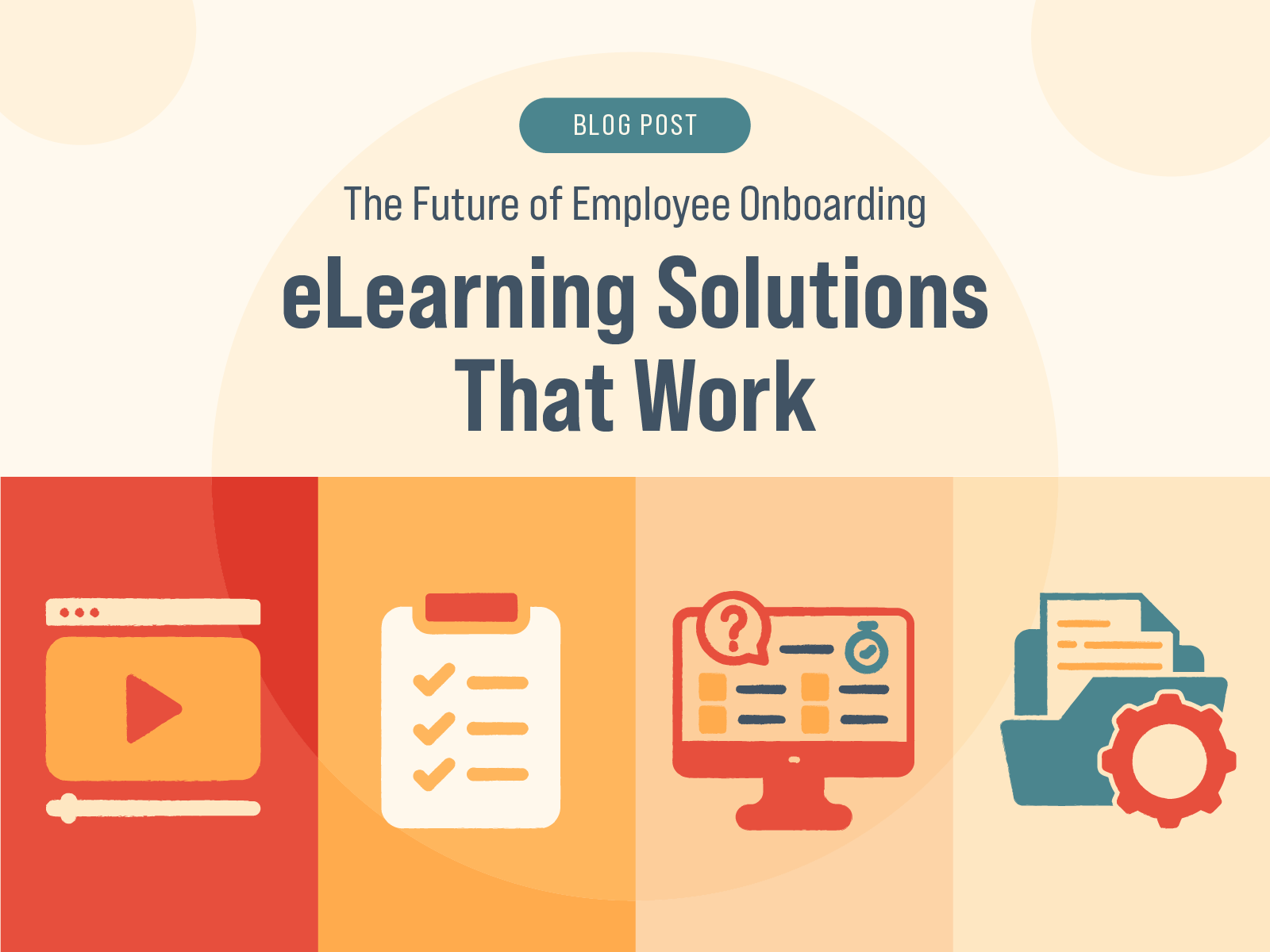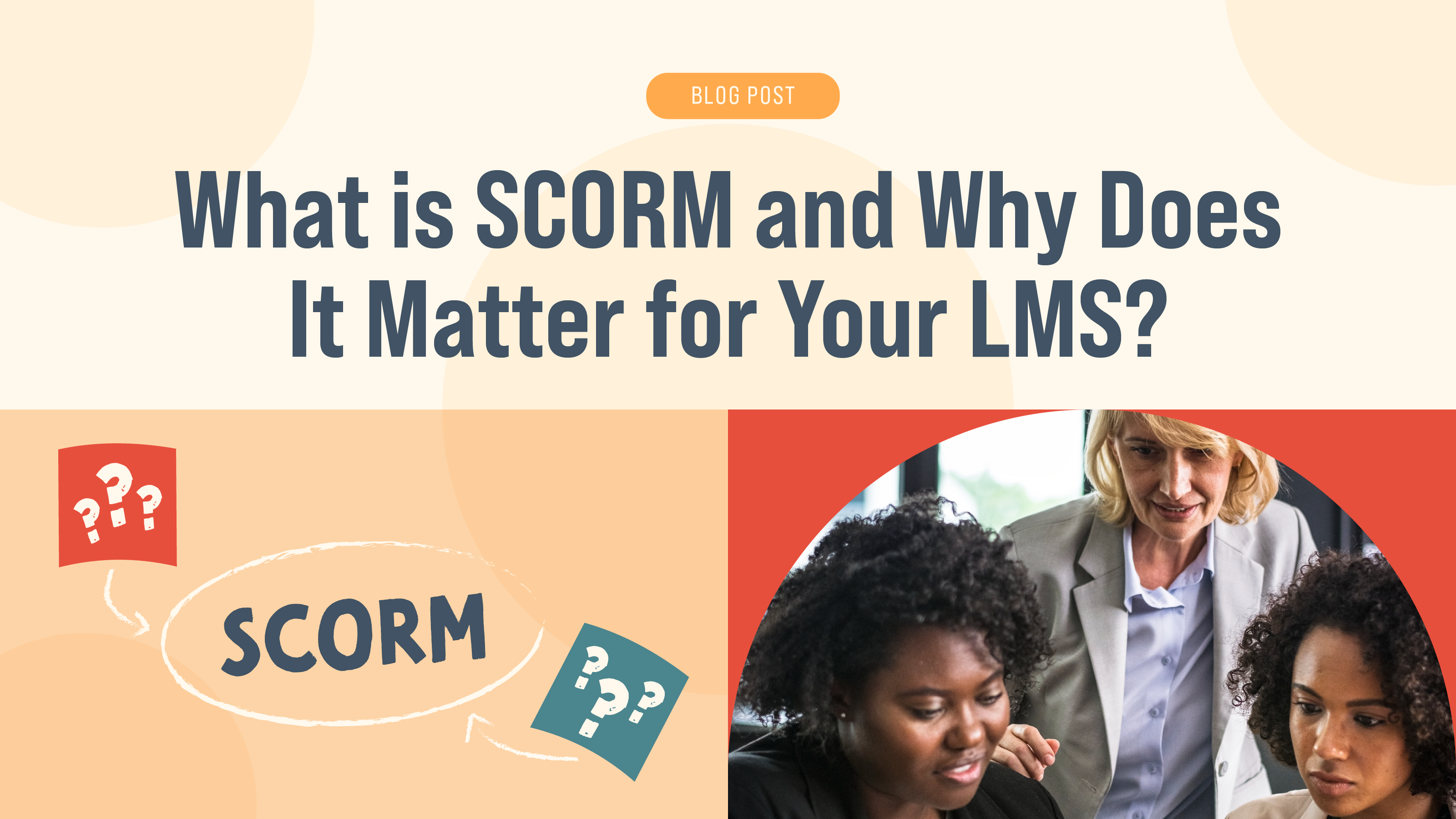Gamification in the Workplace: Why and How to Use It
Let’s face it: the workplace can be dry. Gamification at work is a simple yet effective method of engaging and motivating employees during non-game activities. It can also make those mandatory tasks on your to-do list that much more fun.
Consider that your teams are likely more willing to participate in mandatory courses on topics such as workplace safety if they could collect points and earn rewards along the way. Other gamification concepts include leaderboards, scores, and badges.
What Is Gamification?
You might be wondering: what is gamification in the workplace and what is the gamification definition? Gamification uses game techniques in a non-game context to help entice the learner to interact more with the material. Many companies lean on gamification to help create internal competitions to instill a sense of healthy competition within the workplace. By implementing scores, levels, and prizes as extra motivation, gamification can help your employees feel excited about learning new material.
A recent study shows that 83% of people who received gamification training felt motivated while 61% of those who received non-gamified training reported feeling bored and unproductive. If you haven’t considered implementing this tactic in your company, now is the time to do so!
Gamification at Work: Examples
Gamification is relevant for nearly any industry or company size. If you need a bit of inspiration on how to gamify your workplace, consider the following biggest workplace gamification trends.
- Employees who receive the highest scores on company-wide assessments on workplace safety will be able to choose one item of company swag. This simple yet impactful tactic can encourage your employees to pay more attention to the material so they answer relevant questions correctly. Without gamification, your employees may rush through the material to complete it as quickly as possible.
- Companies have built a library of online eLearning courses on varying topics. Employees who complete a course will get a gift certificate of their choice. This tactic motivates your employees to continue to build upon their skill sets.
- Rather than using presentations or manuals to train your employees, consider creating online mini-courses that have characters, quizzes, and a scoring system.
Implementing the above tactics can transform the way that your employees learn and grow with your company. We’ve outlined some examples of corporate gamification below.
Game-Based Learning and Employee Training

One example of gamification in the workplace consists of mini-courses that have interesting characters, fun quizzes, and other assessment factors. By incorporating these features instead of presentations or manuals, you help to increase employee engagement and interest and pinpoint areas where growth is needed.
Encourages Employee Certification
Another tactic to engage employees is providing them with an online certificate once they’ve completed a course. As you continue to add more online courses to your database, you can create separate certificates for each one. By encouraging employees to collect certificates surrounding a range of topics, you encourage employee development.
Interactive Leaderboards
There’s nothing more motivating than seeing other employees at your company go through each course. Establishing an interactive leaderboard instills a healthy level of competition and helps get employees excited about completing more courses. Game-based motivation is especially helpful for sales reps and employees who want to go above and beyond expectations.
On-the-Spot or Social Media-Style Recognition
Corporate gamification can always benefit from spontaneity and intermittent rewards. Employees have a higher chance of learning and repeating this good behavior if they receive an unexpected reward along the way. On-the-spot recognition is unexpected yet very appreciated by your employees and can easily be shared on social media to build recognition.
Spin-to-wins and Scratch-off Bonuses
Don’t be afraid to revert to simple game mechanics in your workplace gamification efforts. Spin-to-win games and scratch-offs give your employees a sense of excitement and keep them on their toes.
Badging and Achievements
Another way to gamify the workplace is to provide employees with badges. This is a simple way to visualize their achievements and make them more likely to get excited and share their progress with other employees.
Goal-Tracking Progress Bars
Encouraging your employees to work toward specific goals can help them stay productive and engaged. It’s common for gamification in business to include specific goals to help employees track progress and feel a sense of accomplishment.
Rewards for Company Competitions
Who doesn’t love a reward for winning a competition? Not all examples of gamification in the workplace need to revolve around productivity. Occasionally, consider boosting employee morale by encouraging your team to have fun with one another. This could mean cook-offs, costume contests, or friendly competitions.
Swag Bags for the Highest Score

Your employees could feel motivated to complete more courses if they’re awarded a swag bag if they get the highest score. Simply put together a bag of offerings such as company pens, sweatshirts, t-shirts, mugs, or other appealing items.
Qualification-Based Travel Events
A simple way to boost employee engagement is by motivating them with travel. If employees know that their hard work could result in exclusive travel, it could motivate them to pay attention to the material that much more.
Benefits of Gamification in the Workplace
Gamification benefits for employees are expansive and shouldn’t be overlooked. We’ve outlined a handful of them below.
Increases Engagement, Motivation, and Productivity

Gamification for employee engagement helps present information or tasks in a more challenging manner. Employees will feel that much more satisfied and accomplished when they finish a more difficult training, resulting in feeling more satisfied. Companies that use gamification have found that productivity increases by 50% and employee engagement increases by 60%. When you show your employees that you are willing to help them reach their maximum potential, you will keep high-value employees around for longer.
Improves the Work Environment
Another gamification benefit is that it improves the overall work environment. Employees will undoubtedly deliver their best work when they are surrounded by a healthy work environment. For example, if the current work revolves around specific employees constantly receiving praise from higher-ups, other employees may not feel motivated. Gamification gives all employees a level playing field to demonstrate their value to the company.
Boosts Employee Advocacy
One important purpose of gamification is to increase employee advocacy. By implementing gamification tactics at your workplace, you can boost your company’s image. As soon as an employer recognizes their employees, they are more likely to share their experience with others on social media. Not only will gamification keep employees motivated and engaged with the company’s material but they will become the voice of your organization. In return, this will help to build the reputation and following of your company.
Enhances Teamwork
In any organization, teamwork plays a positive role in bringing people together. As soon as like-minded individuals join forces to pursue a common goal, nothing will stand in their way! By gamifying the workplace, you encourage your employees to come together who have similar perspectives and work ethics. By creating a more teamwork-focused work environment, you cultivate a healthy employee culture centered around growth.
It Offers Real-Time Feedback
Annual reviews have a way of sneaking up on employees. When gamification tactics are used, employees won’t need to work toward irrelevant or outdated goals by the time their review rolls around. Instead, they can put effort into real-time, measurable goals and get feedback along the way.
Makes Day-to-Day Work-Life More Enjoyable
Here are some ways that gamification can improve life at work:
- Gamification helps to tap into the brain’s natural wiring by providing employees with rewards
- As soon as an employee performs an action, they’ll receive a reward for doing so. This triggers the brain to release dopamine which is referred to as the feel-good neurotransmitter
- Then, the employee is invited to perform the same action with the hopes of getting the same positive result
How Gamification Increases Employee Engagement
If you’re looking to boost employee engagement, look no further than gamification. The more engaged your employees are, the more desirable it is for them to stay at your company. According to a survey conducted by TalentLMS, here are some ways that employee engagement increases:
- 89% of employees who use gamification at work report feeling happier
- 89% of employees who use gamification at work report feeling more productive
- 78% of survey respondents reported that if a company uses gamification while recruiting, the company is more desirable
- 83% of employees who use gamification at work feel more motivated during training (61% of non-gamified employees feel unmotivated)
The more that you can associate an employee’s job with positivity, the more inclined they’ll be to stay.
How to Use Gamification at Work
If you need to know how to gamify work to increase employee engagement and motivation, here are some tips to get you started.
Clearly Communicate Game Goals and Processes

Employee gamification in the workplace starts by ensuring that your team has an in-depth understanding of the goal of the game and how it works. For example, you want to use gamification with your sales team to help close a certain number of contracts within three months. Before kicking off this initiative, it’s important to communicate the following:
- The goals of the game
- The criteria to let them know if they’ve won
- Rewards they’ll receive for winning, placing second, etc.
- Benefits to the business and to the employees achieving the goals
- Rules, particularly any that disqualify an employee
The rules should always be very clear to those participating to reduce the risk of creating an unfair race. Emphasizing a sense of purpose is equally important as a sense of achievement. Always communicate the purpose clearly and early on.
Include Gamification in Training
Building gamification eLearning courses is another tactic to entice employees to learn and grow. While training is often associated with dry, boring material that employees are forced to learn, by implementing gamification, you can build a culture of friendly competition.
Here are some common gamification features to include in your courses:
- Points: They earn points as they complete taskFs, achieve desired results, or simply log onto the platform.
- Leaderboards: Learners can compete against one another to earn the highest number of points and to find a leader among their peers. By including a leaderboard, you add an exciting, dynamic addition to learning.
- Badges: Reward course completion and noteworthy results with virtual badges! As learners navigate through the course, they will accumulate badges on their profiles.
- Rewards: Consider implementing real-life rewards like company swag, online gift cards, or other participation incentives.
Offer Desirable Rewards
Offering desirable rewards is an essential tactic when incorporating gamification into the workplace. Keep in mind that not everyone is after the same incentives. Try to ensure that the rewards you’re offering are relevant and desirable to employees. If not, they won’t feel a sense of further motivation to complete the training or interact with the material.
For example, maybe you’re running a “star employee” program that offers rewards for exceptional achievement. Consider the employee’s perspective: will a digital badge be enough to keep them motivated in the long run? The novelty of winning a digital badge will quickly wear off. Consider a more enticing prize like a weekend away, a gift card to a restaurant, or a couple of extra PTO days. Get creative with the types of rewards you’re offering as every employee engages with work differently.
Recognize Everyone’s Contribution

Another aspect of employee gamification in the workplace is recognizing that everyone is different when it comes to learning. Maybe you’re using gamification to improve the participation level in training and workplace activities. Make sure everyone in the organization feels like it’s worth it to participate, it’s not all about the achievement.
Consider the different kinds of rewards that you can offer for simply completing a training course or hitting a KPI benchmark. Public recognition can go a long way in rewarding participation.
Track the Success
Like any new company initiative, you must measure both your successes and your failures to improve. Gamification undoubtedly offers many benefits but it isn’t guaranteed to achieve results. In some cases, gamification can have benefits that extend beyond the goals that you originally intended.
If possible, set up an analytics dashboard that tracks how your gamification program performs against the original goals that you created. Track variables such as the number of employees who participate in the program, the number of people who complete the goals, and how the overall job performance has improved since the start of the gamification program.
In the case that you cannot compile participant statistics, consider how you recognize and reward your participants. Maybe the overall job performance doesn’t improve at the same volume that you expected. In this case, adjust your initiative to better align with your business goals and your KPIs.
Reflect on Performance
Just as you track the successes and failures of employee gamification, make sure that employees have the opportunity to reflect on areas in that they succeeded and areas that they failed. For example, let’s say an employee was not able to close enough contracts during the sales team’s 3-month challenge. What will you do to show the employee what they could have done differently to achieve the goal?
You can close every game or challenge with a recap that highlights both the successes and failures of the program. Focus part of this session on what the individual employees are doing well so that others can learn from their mistakes.
Where and How to Implement Gamification in the Workplace
Implementing gamification in the workplace doesn’t need to be expensive or complicated. We’ve outlined some helpful strategies below.
Gamification in Employee Recognition
While it may seem obvious that you should pay employees on the back for a job well done, did you know that you can also add another layer of fun? Maybe you develop a points system where employees who do a good job on a particular task earn 5 points. If an employee appreciates another employee’s work, they get 10 points. At the end of the month or the quarter, tally these points and give rewards to employees who have earned the most.
Gamification in Employee Wellness
As employees spend most of their days in front of a computer screen, they likely don’t get much physical movement during the day. Many corporations are relying on gamification solutions for a cost-effective way to navigate potential health issues. Consider setting step targets that your employees should hit in a day or within a certain timeframe.
Gamification in Performance Management
Gamification makes it simple to motivate your employees to perform at the top of their game. Design a program in which employees are encouraged to complete a certain amount of work at a certain time, factoring in quality along the way. When the challenge is over, you can reward the employee with the most points.
Gamification in Learning
An eLearning platform can act as a hub that engages employees and teaches them new materials. This hub is useful for employee onboarding in addition to ongoing employee professional development. As the courses are flexible and accessible from anywhere, it allows teams to get through the material at their own pace.
Gamified Onboarding
Gone are the days of onboarding the old-fashioned way. Gamify onboarding by creating different courses to help them learn new skills and earn certifications along the way. This is also a great tactic in training existing employees and ensuring they’re updated on your latest company policies and procedures.
Call Center and Help Desk Motivation Through Gamification

More call centers are leaning on gamification to overcome employee engagement issues. Instill a sense of friendly competition to help motivate your call center employees to outperform one another, hitting service KPIs and goals along the way.
Gamifying Sales Competitions
In the same vein, you can also add a competitive edge to sales competitions to motivate your sales team to close more deals. Consider rewarding the top salesman or saleswoman who has brought in the most business for the company during a certain time.
Future of Enterprise Gamification
The importance of gamification cannot be overstated, and more and more companies are exploring its benefits. By empowering employees to live in a results-oriented world, they will get a sense of mastery and purpose. There is great potential for gamification in enterprise companies to yield significant results and bring value to each employee’s daily tasks.
Need Help Implementing Gamification Into the Workplace?
It can feel daunting and overwhelming to make changes to how employees interact with your workplace, but gamification is a unique tactic that yields successful results. If you’re interested in hands-on guidance from gamification and eLearning experts, our team at Allegro Media Design is happy to help! To learn more about our process and our offerings, please contact us!


















































































%20to%20Virtual%20Instructor-Led%20Training%20(VILT).jpg)


%20vs.%20eLearning.jpg)

